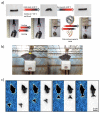Magnetic Self-Healing Composites: Synthesis and Applications
- PMID: 35744920
- PMCID: PMC9228312
- DOI: 10.3390/molecules27123796
Magnetic Self-Healing Composites: Synthesis and Applications
Abstract
Magnetic composites and self-healing materials have been drawing much attention in their respective fields of application. Magnetic fillers enable changes in the material properties of objects, in the shapes and structures of objects, and ultimately in the motion and actuation of objects in response to the application of an external field. Self-healing materials possess the ability to repair incurred damage and consequently recover the functional properties during healing. The combination of these two unique features results in important advances in both fields. First, the self-healing ability enables the recovery of the magnetic properties of magnetic composites and structures to extend their service lifetimes in applications such as robotics and biomedicine. Second, magnetic (nano)particles offer many opportunities to improve the healing performance of the resulting self-healing magnetic composites. Magnetic fillers are used for the remote activation of thermal healing through inductive heating and for the closure of large damage by applying an alternating or constant external magnetic field, respectively. Furthermore, hard magnetic particles can be used to permanently magnetize self-healing composites to autonomously re-join severed parts. This paper reviews the synthesis, processing and manufacturing of magnetic self-healing composites for applications in health, robotic actuation, flexible electronics, and many more.
Keywords: actuators; health; magnetic (nano)particles; magnetic fillers; magnetic self-healing composites; manufacturing; processing; slippery surfaces; stretchable electronic; synthesis.
Conflict of interest statement
The funders had no role in the design of the study; in the collection, analyses or interpretation of the data; in the writing of the manuscript or in the decision to publish the results.
Figures









References
-
- Garcia-Merino B., Bringas E., Ortiz I. Synthesis and applications of surface-modified magnetic nanoparticles: Progress and future prospects. Rev. Chem. Eng. 2021 doi: 10.1515/revce-2020-0072. - DOI
-
- Batlle X., Moya C., Escoda-Torroella M., Iglesias O., Fraile Rodríguez A., Labarta A. Magnetic nanoparticles: From the nanostructure to the physical properties. J. Magn. Magn. Mater. 2021;543:168594. doi: 10.1016/j.jmmm.2021.168594. - DOI
-
- Wang S., Urban M. Self-healing polymers. Nat. Rev. Mater. 2020;5:562–583. doi: 10.1038/s41578-020-0202-4. - DOI
Publication types
MeSH terms
Grants and funding
LinkOut - more resources
Full Text Sources

